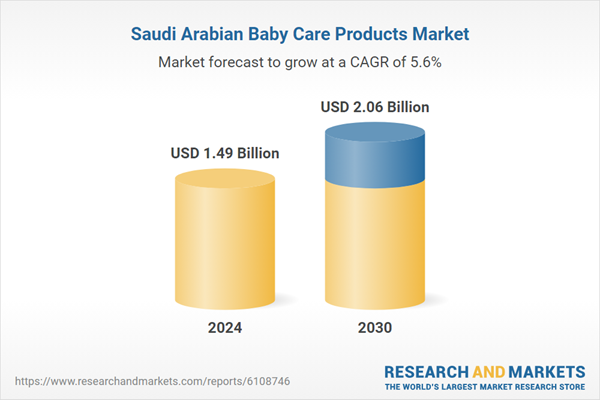Speak directly to the analyst to clarify any post sales queries you may have.
10% Free customizationThis report comes with 10% free customization, enabling you to add data that meets your specific business needs.
Urbanization, along with economic advancement and increased female workforce participation, has led to a surge in dual-income families, particularly in urban areas. This demographic shift supports the adoption of convenient, high-quality baby care solutions. According to the Saudi Ministry of Health, conditions like atopic dermatitis, which affects nearly 25% of children, are also encouraging demand for gentle and specialized baby care products. These developments underscore the ongoing growth potential across skincare, hygiene, and wellness-focused product categories.
Key Market Drivers
Increasing Birth Rates and Growing Population
The consistently high birth rate and expanding population base in Saudi Arabia are key contributors to the growing demand for baby care products. A rising number of infants and toddlers has led to sustained consumption of items such as diapers, baby wipes, shampoos, lotions, and skin-care essentials. In 2023, the country recorded approximately 18.3 births per 1,000 people, while children under the age of five numbered around 3.1 million as of 2024, according to data from the General Authority for Statistics. This steady increase in the child population ensures a strong and ongoing demand for daily-use baby products. Additionally, the prevalence of young, dual-income families seeking safe, reliable, and easy-to-use care solutions further amplifies the market need. These demographic dynamics continue to fuel the growth of both mass-market and premium product segments across urban and suburban regions.Key Market Challenges
High Competition and Price Sensitivity
The Saudi Arabia baby care products market faces significant challenges stemming from intense competition among global and domestic brands. With a broad spectrum of products available - ranging from economy options to high-end, organic formulations - manufacturers must work harder to differentiate through quality, pricing, and innovation. Although rising disposable incomes have led to a growing preference for premium goods, a large portion of the consumer base remains price-sensitive, especially when purchasing frequently used items such as diapers and wipes. This pushes brands to maintain cost competitiveness without compromising on quality. Furthermore, the influx of low-cost products from new entrants complicates market dynamics by creating pricing pressure for established players, challenging them to balance affordability and brand loyalty while expanding their product reach.Key Market Trends
Growing Demand for Organic and Natural Products
One of the most prominent trends shaping the Saudi baby care market is the shift toward organic, natural, and chemical-free products. As parents become more conscious of product safety and long-term health effects, there is a rising preference for skin-care and hygiene products made with gentle, plant-based ingredients like aloe vera, chamomile, and shea butter.This demand aligns with broader global movements favoring sustainability and wellness-focused consumption. Increasing concerns about allergies and sensitivities have further driven the popularity of hypoallergenic and eco-friendly alternatives. Digital platforms - such as parenting blogs and influencer-led content - have also played a pivotal role in spreading awareness and influencing purchasing behaviors. In response, both local and international brands are innovating with formulations that highlight organic certifications and offer biodegradable packaging, reinforcing their appeal to health-conscious and environmentally aware consumers.
Key Market Players
- Nestle SA
- Procter & Gamble Co.
- Unicharm Corporation
- Danone SA
- Kimberly-Clark Corporation
- Unilever PLC
- Johnson & Johnson
- Himalaya Global Holdings Ltd
- Honasa Consumer Pvt. Ltd
- Daxal Cosmetics Private Limited
Report Scope:
In this report, the Saudi Arabia Baby Care Products Market has been segmented into the following categories, in addition to the industry trends which have also been detailed below:Saudi Arabia Baby Care Products Market, By Product Type:
- Skin Care
- Hair Care
- Toiletries
- Others
Saudi Arabia Baby Care Products Market, By Category:
- Premium
- Mass
Saudi Arabia Baby Care Products Market, By Sales Channel:
- Online
- Specialty Stores
- Supermarkets/Hypermarkets
- Others
Saudi Arabia Baby Care Products Market, By Region:
- Western
- Northern & Central
- Eastern
- Southern
Competitive Landscape
Company Profiles: Detailed analysis of the major companies present in the Saudi Arabia Baby Care Products Market.Available Customizations:
With the given market data, the publisher offers customizations according to a company's specific needs. The following customization options are available for the report.Company Information
- Detailed analysis and profiling of additional market players (up to five).
This product will be delivered within 1-3 business days.
Table of Contents
Companies Mentioned
- Nestle SA
- Procter & Gamble Co.
- Unicharm Corporation
- Danone SA
- Kimberly-Clark Corporation
- Unilever PLC
- Johnson & Johnson
- Himalaya Global Holdings Ltd
- Honasa Consumer Pvt. Ltd
- Daxal Cosmetics Private Limited
Table Information
| Report Attribute | Details |
|---|---|
| No. of Pages | 87 |
| Published | July 2025 |
| Forecast Period | 2024 - 2030 |
| Estimated Market Value ( USD | $ 1.49 Billion |
| Forecasted Market Value ( USD | $ 2.06 Billion |
| Compound Annual Growth Rate | 5.5% |
| Regions Covered | Saudi Arabia |
| No. of Companies Mentioned | 10 |









